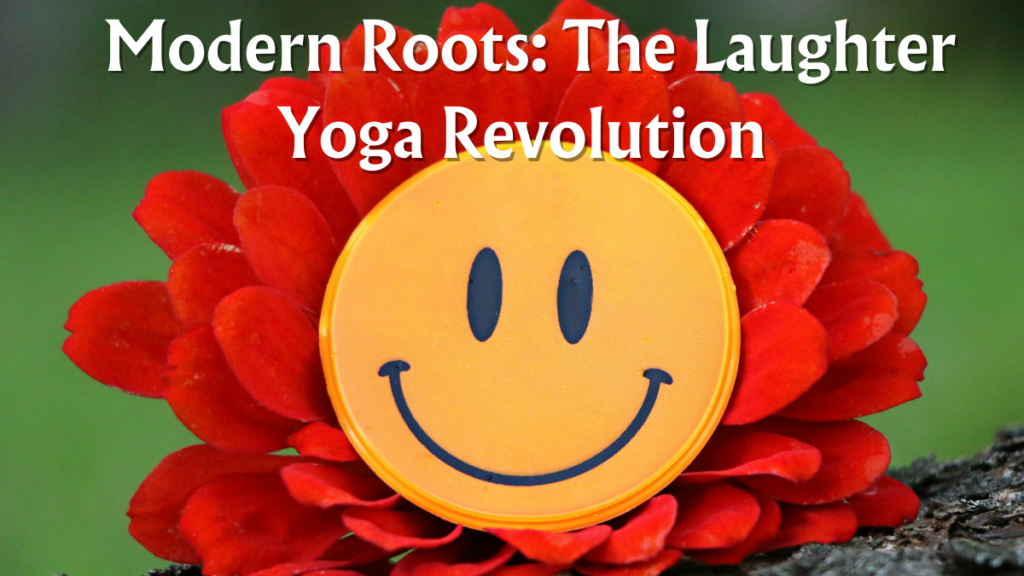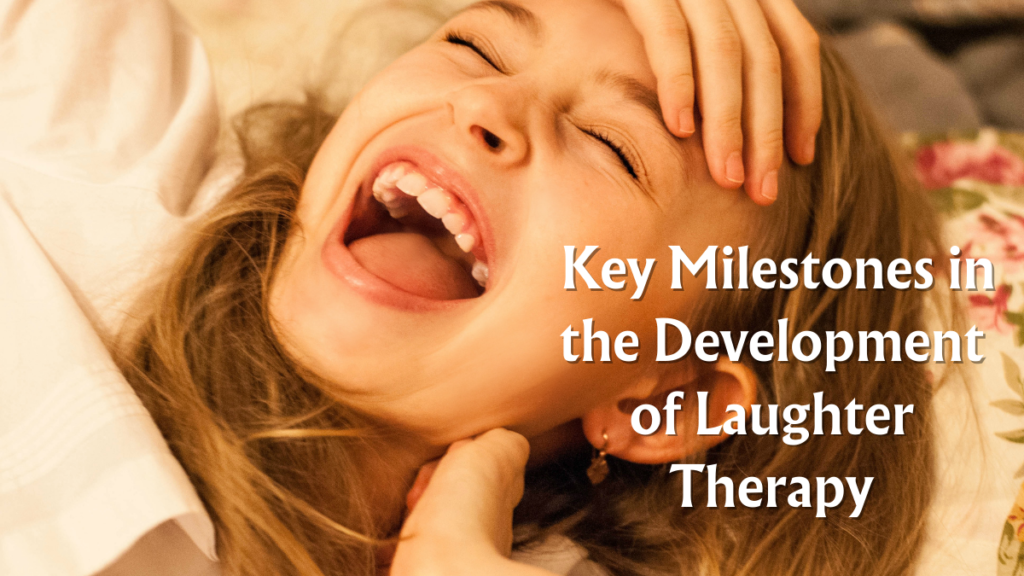The Evolution of Laughter Therapy: From Ancient Wisdom to Modern Wellness, 10 FAQs About Laughter Yoga
Introduction: Rediscovering the Ancient Medicine of Laughter
Laughter therapy, also known as laughter yoga, is not merely a modern wellness trend; it has roots deeply embedded in ancient traditions. The therapeutic power of laughter has been recognized and harnessed across cultures for centuries, evolving into the structured laughter therapy we know today.

Ancient Wisdom: Laughter in Traditional Medicine
1. Ancient India: Yogic Laughter
In ancient India, the practice of yoga included laughter as a component of overall well-being. Yogis understood the profound impact of laughter on the body, mind, and spirit. Laughter, integrated into yogic philosophy, was seen as a way to achieve balance and harmony within oneself.
2. Chinese Medicine: Balancing Qi with Laughter
Chinese medicine, with its emphasis on the balance of vital energy or Qi, recognized laughter as a means to harmonize the body’s energy flow. Ancient Chinese healing practices, including Qigong, incorporated laughter to promote health and longevity.

Modern Roots: The Laughter Yoga Revolution
3. Dr. Madan Kataria’s Innovation (1995)
The formalization of laughter therapy as we know it today traces back to the efforts of Dr. Madan Kataria, an Indian physician. In 1995, Dr. Kataria founded the first laughter club in Mumbai, inspired by the idea that laughter could be a form of preventive and therapeutic medicine.
4. Laughter Clubs Spread Globally
The laughter club movement quickly gained momentum, spreading beyond India to become a global phenomenon. Laughter clubs emerged in diverse locations, from parks to community centers, with participants engaging in intentional laughter exercises.

Key Milestones in the Development of Laughter Therapy
5. Laughter Yoga International (1998)
Dr. Kataria’s vision led to the formation of Laughter Yoga International in 1998. This organization played a pivotal role in promoting laughter yoga as a structured practice and training laughter yoga leaders worldwide.
6. Laughter as a Complementary Therapy
Laughter therapy found its place as a complementary therapy in healthcare settings. Medical professionals recognize its potential to alleviate stress, enhance mood, and contribute to overall well-being.

Scientific Validation and Recognition
7. Research on Laughter’s Health Benefits
Scientific research began to explore the physiological and psychological benefits of laughter. Studies revealed its impact on stress hormones, immune function, and cardiovascular health, providing a scientific foundation for the therapeutic value of laughter.
8. Laughter Yoga in Healthcare Settings
Laughter therapy gained acceptance in conventional healthcare settings. Hospitals, wellness centers, and rehabilitation facilities started incorporating laughter yoga as part of holistic patient care.

Contemporary Applications and Global Impact
9. Laughter Therapy in Corporate Wellness (2000s)
As workplaces recognized the importance of employee well-being, laughter therapy found its way into corporate wellness programs. Laughter sessions became a tool for stress management and team-building exercises.
10. Popularity in Mental Health Practices
Laughter therapy gained recognition in mental health practices. Therapists began incorporating laughter exercises into counseling sessions, acknowledging its positive impact on mood and emotional resilience.

Online Laughter Sessions and Adaptations
11. Digital Laughter Yoga (2020s)
The digital age brought about a shift to online platforms, making laughter therapy accessible to a global audience. Virtual laughter sessions became a source of joy and connection, especially during challenging times.
12. Adaptations for Special Populations
Laughter therapy is adapted to cater to diverse populations, including children, seniors, and individuals with specific health challenges. Specialized laughter programs were developed to address unique needs.

The Future: Laughter as a Universal Language of Wellness
13. Ongoing Research and Innovation
Ongoing research continues to explore the multifaceted benefits of laughter therapy. Innovations in laughter interventions and the integration of technology are shaping the future of this ancient yet continually evolving practice.
14. Laughter as a Cultural Connector
Laughter therapy transcends cultural boundaries, emerging as a universal language of wellness. Its ability to foster connection and joy positions it as a timeless and invaluable aspect of human well-being.

Conclusion: A Joyful Path to Holistic Health
Laughter therapy’s journey from ancient practices to modern applications reflects its enduring relevance in promoting holistic health. As it continues to evolve and gain recognition, laughter therapy stands as a testament to the timeless wisdom that laughter is indeed a potent medicine for the body, mind, and soul.
Frequently Asked Questions (FAQs) About Laughter Therapy
1. Is laughter therapy suitable for everyone?
– Yes, laughter therapy is generally suitable for individuals of all ages and fitness levels. However, individuals with specific health concerns or conditions should consult with a healthcare professional before starting laughter therapy.
2. How does laughter therapy work?
– Laughter therapy typically involves intentional laughter exercises, deep breathing, and mindfulness. The combination of laughter and controlled breathing contributes to physical, mental, and emotional well-being.
3. Can laughter therapy replace traditional medical treatment?
– Laughter therapy is considered a complementary approach to traditional medical treatment. While it offers numerous health benefits, individuals should not replace prescribed medical treatments with laughter therapy without consulting their healthcare providers.
4. Are there different types of laughter therapy?
– Yes, there are various approaches to laughter therapy, including laughter yoga, laughter meditation, and laughter exercises. These variations cater to different preferences and settings, from group sessions to individual practices.
5. How long does it take to experience the benefits of laughter therapy?
– The timeline for experiencing benefits varies among individuals. Some may notice positive effects after a few sessions, while others may take several weeks. Consistency is key to maximizing the benefits of laughter therapy.
6. Can laughter therapy be practiced alone?
– Yes, laughter therapy can be practiced alone. There are guided resources, online sessions, and laughter exercises that individuals can engage in independently. However, group laughter sessions can offer additional social benefits.
7. Is laughter therapy only about humor and jokes?
– While humor and jokes can be part of laughter therapy, it doesn’t rely solely on external stimuli. Laughter exercises involve intentional laughter, often starting as simulated laughter and evolving into genuine laughter, regardless of external comedic elements.
8. Are there any age restrictions for participating in laughter therapy?
– Laughter therapy is generally suitable for all age groups, including children, adults, and seniors. Modifications can be made to accommodate different physical abilities and preferences.
9. Can laughter therapy help with mental health conditions?
– Laughter therapy has shown positive effects on mental health by reducing stress, improving mood, and enhancing emotional resilience. However, individuals with mental health conditions should consult mental health professionals for comprehensive support.
10. How often should one practice laughter therapy?
– The frequency of laughter therapy sessions can vary based on individual preferences and schedules. Some may benefit from daily sessions, while others may find a few times a week sufficient. Consistent practice is encouraged for sustained benefits.
https://en.wikipedia.org/wiki/Peter_Funt#Laughter_Therapy_Foundation






